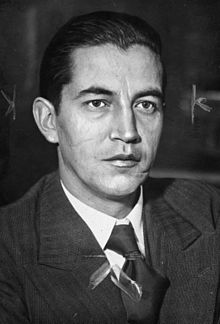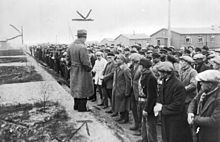Rudolf Diels
Rudolf Diels | |
|---|---|
 Rudolf Diels in 1933 | |
| Director of the Gestapo | |
| In office 26 April 1933 – 1934 | |
| Appointed by | Hermann Göring |
| President | Paul von Hindenburg Adolf Hitler (Führer) |
| Chancellor | Adolf Hitler |
| Preceded by | none |
| Succeeded by | Reinhard Heydrich |
| Personal details | |
| Born | 16 December 1900 Berghausen, Prussia, German Empire |
| Died | 18 November 1957 (aged 56) Katzenelnbogen, West Germany (hunting accident) |
| Political party | National Socialist German Workers' Party (NSDAP) |
| Spouse | Hilde[1] |

Rudolf Diels (16 December 1900 - 18 November 1957)[2] was a German civil servant and head of the Gestapo in 1933-34.[3][4] He is also referred to as an SS-Oberführer.[2][3] He was a protégé of Hermann Göring.[3]
Early life
Diels was born in Berghausen in the Taunus,[2] the son of a farmer.[3] He served in the army during World War I and afterwards studied law at the University of Marburg from 1919. At university he had a reputation as a drinker and philanderer.[1]: 64 While there he also received a number of dueling scars resulting from the academic fencing once practised by young upper-class Austrians and Germans in trying to prove their manhood. The scars did not greatly detract from his good looks and in fact imparted a quite striking appearance.[1]: 116
Gestapo chief
He joined the Prussian interior ministry in 1930 and was promoted to an advisory position in the Prussian police in 1932, targeting political radicals, both Communists and Nazis. He was head of the Prussian Political Police when Adolf Hitler came to power. Göring was made minister for Prussia in 1933, replacing Carl Severing, and was impressed with Diels' work and new-found commitment to the Nazi Party. In April 1933 Göring appointed him as chief of the new Prussian state police department 1A, concerned with political crimes.[3] Department 1A was soon renamed the Geheime Staatspolizei (Secret State Police), or Gestapo. On February 27, 1933 the Reichstag fire occurred,[5] and Diels was the main interrogator of the principal accused, Marinus van der Lubbe.[2] He heard Hitler shouting through the fire "these sub-humans do not understand how the people stand at our side. In their mouse-holes, out of which they now want to come, of course they hear nothing of the cheering of the masses."[6] He also ordered Arthur Nebe to arrange the killing of Gregor Strasser in October 1933; ironically Strasser was later killed during the Night of the Long Knives in which Diels himself was almost killed.
Diels soon attracted the attention of political rivals, including Heinrich Himmler and Reinhard Heydrich.[3] Himmler was head of the SS at the time.[1]: 138 Effectively smeared, but with Göring's aid, he narrowly avoided execution during the Night of the Long Knives,[3] fleeing his post for five weeks. Diels was dismissed on 1 April 1934 and control of the Gestapo was formally given to Himmler on 20 April 1934. Heydrich, named chief of the Gestapo by Himmler on 22 April 1934, also continued as head of the SS Security Service (Sicherheitsdienst, SD).[7] Thereafter, Diels was briefly Deputy Police President of Berlin before being appointed to the local government of Cologne as a Regierungspräsident.[3]
He maintained his association with Göring, marrying a cousin of his protector.[2] Göring saved him from prison on a number of occasions, notably once in 1940 when he declined to order the arrest of Jews, and more vitally in 1944 after the 20 July Plot to assassinate Hitler.[2]
Nuremberg trials
Diels presented an affidavit for the prosecution at the Nuremberg trials[3] but was also summoned to testify by Göring's defense lawyer.[2]
Post-war
After 1950 he served in the post-war government of Lower Saxony,[2] and then in the Ministry of the Interior, until his retirement in 1953.[3] He died on 18 November 1957 when his rifle accidentally discharged while he was hunting.[1]: 362 [3]
Diels' memoirs, Lucifer Ante Portas: Von Severing bis Heydrich, were published in 1950.[3] A less cautious work was published after his retirement, Der Fall Otto John ("The Case of Otto John") (1954).
Sources
- Larson, Erik (2011). In the Garden of Beasts: Love, Terror, and an American Family in Hitler's Berlin (First ed.). New York: Crown. p. 162. ISBN 978-0-307-40884-6.
- Diels, Rudolf. "Affidavits of Rudolf Diels". Axis History: Holocaust and 20th Century War Crimes. Axis History Forum. Retrieved 14 January 2012.
References
- ^ a b c d e Larson, Erik (2011). In the Garden of Beasts: Love, Terror, and an American Family in Hitler's Berlin. New York: Crown Publishing Group. ISBN 978-0-307-40884-6.
- ^ a b c d e f g h Hopmans, Rob. "Rudolf Diels". World War II Graves. Retrieved 14 January 2012.
- ^ a b c d e f g h i j k l Simkin, John. "Rudolf Diels". Spartacus Educational. Retrieved 14 January 2012.[better source needed]
- ^ Larson, Erik (2011). In the Garden of Beasts: Love, Terror, and an American Family in Hitler's Berlin. New York: Crown. pp. 117–118, 138–140. ISBN 978-0-307-40884-6.
- ^ Diels, Rudolf. "Rudolf Diels, Head of the Prussian Political Police, on the Reichstag Fire of 27 February 1933 (Retrospective Account, 1949)". German History in Documents and Images (GHDI). Retrieved 14 January 2012.
- ^ Robert Gellately (8 March 2001). Backing Hitler: Consent and Coercion in Nazi Germany. Oxford University Press. p. 18. ISBN 978-0-19-160452-2.
- ^ Williams, Max (2001). Reinhard Heydrich: The Biography: Volume 1. p. 61. ISBN 978-0-9537577-5-6
